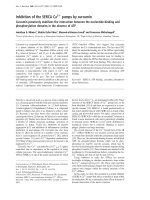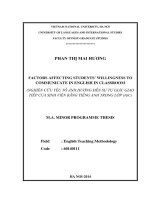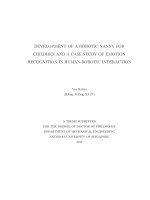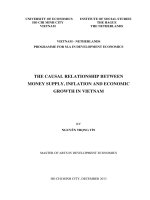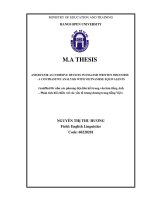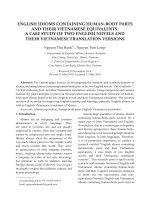Intercultural interaction between vietnamese military students and foreign teachers in english classroom context a case study of a military school
Bạn đang xem bản rút gọn của tài liệu. Xem và tải ngay bản đầy đủ của tài liệu tại đây (506.18 KB, 121 trang )
VIETNAM NATIONAL UNIVERSITY, HANOI
UNIVERSITY OF LANGUAGES AND INTERNATIONAL STUDIES
FACULTY OF POST-GRADUATE STUDIES
*************************
NGÔ THỊ CHÚC
INTERCULTURAL INTERACTION BETWEEN
VIETNAMESE MILITARY STUDENTS AND FOREIGN
TEACHERS IN ENGLISH CLASSROOM CONTEXT: A
CASE STUDY OF A MILITARY SCHOOL
(SỰ TƯƠNG TÁC LIÊN VĂN HÓA GIỮA SINH VIÊN QUÂN SỰ VIỆT NAM
VỚI GIÁO VIÊN NGƯỜI NƯỚC NGOÀI TRONG LỚP HỌC TIẾNG ANH:
NGHIÊN CỨU TRƯỜNG HỢP Ở MỘT TRƯỜNG QUÂN SỰ)
M.A MAJOR PROGRAMMME THESIS
Field: ENGLISH LINGUISTICS
Code: 60220201
HA NOI – 2014
VIETNAM NATIONAL UNIVERSITY, HANOI
UNIVERSITY OF LANGUAGES AND INTERNATIONAL STUDIES
FACULTY OF POST-GRADUATE STUDIES
*************************
NGÔ THỊ CHÚC
INTERCULTURAL INTERACTION BETWEEN
VIETNAMESE MILITARY STUDENTS AND FOREIGN
TEACHERS IN ENGLISH CLASSROOM CONTEXT: A
CASE STUDY OF A MILITARY SCHOOL
(SỰ TƯƠNG TÁC LIÊN VĂN HÓA GIỮA SINH VIÊN QUÂN SỰ VIỆT NAM
VỚI GIÁO VIÊN NGƯỜI NƯỚC NGOÀI TRONG LỚP HỌC TIẾNG ANH:
NGHIÊN CỨU TRƯỜNG HỢP Ở MỘT TRƯỜNG QUÂN SỰ)
M.A MAJOR PROGRAMMME THESIS
Field: ENGLISH LINGUISTICS
Code: 60220201
Supervisor: DR. HOÀNG THỊ HẠNH
HA NOI – 2014
DECLARATION BY AUTHOR
I, NGÔ THỊ CHÚC, hereby certify that this thesis, which is entitled “Intercultural
Interaction between Vietnamese Military Students and Foreign Teachers in English
Classroom Context: A Case Study of a Military School”, is created from my original
work. I have firmly declared the contribution of others to my thesis such as data
analysis, practical strategies, and all other research that was employed or reviewed in
my thesis.
This thesis is the result of my own study in the fulfillment of the requirement for the
Degree of Master of Arts at Faculty of Post-Graduate Studies, University of
Languages and International Studies, Vietnam National University, Hanoi.
Hanoi, 2014
Ngô Thị Chúc
i
ACKNOWLEDGEMENTS
This thesis would not have been finished without the assistance I received from
many people and organisations. I would like to express my thankfulness to:
my supervisor, Dr. Hoànng Thị Hạnh for being immeasureably helpful for
my work and for her detailed advice, invaluable comments and suggestions.
Without her endless support this thesis would have been impossible.
the students and teachers who have participated in the study with their
priceless time, attempt and keenness.
the staff at the studied military school for their valuable support during my
data collection process.
Ms. Lê Minh Thu for her precious help in inviting the foreign teachers to
participate in this research.
my sister, Ngô Thị Nhâm, for her endless support and encouragement.
the Post-Graduate staff and my classmates at the University of Languages
and International Studies, Vietnam National University, Hanoi for providing
me with basic knowledge about how to structure a research project and the
opportunity to improve my research knowledge and skills.
my colleagues at Military Academy of Logistics for their support,
encouragement and constructive comments on my work.
my parents and parents-in-law for their wholehearted support and
motivation.
my small family including my husband, Phạm Ngọc Hiệp, and my daughter
Phạm Trúc Linh for their love and support.
Without their support and collaboration, this thesis would have been impossible.
ii
ABSTRACT
This study explores the intercultural interaction between Vietnamese military students
and foreign teachers in English classroom context as well as the participants’
perceptions of those interactions using qualitative case study methodology. The
participants are a class of 18 Vietnamese military students and two foreign teachers in
a military school in Hanoi. Four data collection instruments were employed:
classroom observation, retrospective interviews, focus group interviews and
individual open-ended interviews. The interaction were analyzed using Chaudron’s
(1988) interactive features of classroom behaviours and Hofstede’s (1986) nature of
teacher-student interaction related to individualism versus collectivism and power
distance dimensions of culture. The findings show that the teacher-student
intercultural interaction had the characteristics of both individualism and
collectivism, and both large power distance and small power distance. The students
participated quite actively in the lessons. The foreign teachers align themselves with
their own teaching styles with lots of communicative activities during the lessons and
independence of students was encouraged. However, there was a mismatch between
the students’ and teachers’ expectations. The perceptions of both students and
teachers about their classroom interaction were positive. Both student and teacher
participants in this study perceive that differences between two cultures do not hinder
their intercultural interaction in the classroom. Nevertheless, misunderstanding was
hidden during the interaction without being conscious of by both students and
teachers. The findings raise awareness of cultural differences for both students and
teachers involved in intercultural interaction in the classroom. The study proposes
practical suggestions for international teachers of English in Vietnam and Vietnamese
students who study English with foreign teachers in their home country or go
overseas to study, especially in Australia.
iii
NOTES ON QUOTATIONS FROM THE DATA
Excerpt 3.1 – JANE – 20.03:
Excerpt 3.1: Excerpt number 1 in chapter 3
JANE: Pseudonym of the teacher
20.03: The observed lesson was on March, 20
S1: Student number 1
AS: Students
T: Teacher
RI: Quotes taken from retrospective interview
IO: Quotes taken from individual open-ended interview
FG: Quotes taken from focus group interview
Jane-RI21.03:
Jane: Pseudonym of the teacher who produced the quoted utterance
RI21.03: Quote taken from Retrospective Interview taking place on March, 21
Lyn-IO:
Lyn: Pseudonym of the teacher who produced the quoted utterance
IO: Quotes taken from individual open-ended interview
Manh-FG1:
Manh: Pseudonym of the student who produced the quoted utterance
FG1: Quote taken from Focus Group Interview number 1.
[…]: quotations are partly omitted
iv
LIST OF TABLES
Table 1: Vietnamese Teacher-Student Interaction versus Australian
Teacher-Student Interaction Related to the Individualism versus
Collectivism and the Power Distance Dimensions of Culture……………...
14
Table 2: List of Teacher Participants ……………………..………………...
21
Table 3: List of Student Participants ………………..………………………
22
v
LIST OF FIGURES
Figure 1: Comparison of value orientations: Vietnam versus Australia.......
Figure 2: Stages of Data Analysis ……………………..……………………
vi
TABLE OF CONTENTS
DECLARATION BY AUTHOR................................................................................................. i
ACKNOWLEDGEMENTS........................................................................................................ ii
ABSTRACT.................................................................................................................................. iii
NOTES ON QUOTATIONS FROM THE DATA................................................................ iv
LIST OF TABLES......................................................................................................................... v
LIST OF FIGURES..................................................................................................................... vi
TABLE OF CONTENTS.......................................................................................................... vii
PART A: INTRODUCTION....................................................................................................... 1
1. Contextual motivation.............................................................................................................. 1
2. Significance of the study......................................................................................................... 3
3. Aims and scope of the study................................................................................................... 3
3.1 Aims of the study and research questions......................................................................... 3
3.2 Scope of the Study.................................................................................................................. 4
4. Organization of the study........................................................................................................ 4
PART B: DEVELOPMENT........................................................................................................ 5
CHAPTER 1: LITERATURE REVIEWS............................................................................... 5
1. 1 Review of theoretical background for the study............................................................ 5
1.1.1 Culture................................................................................................................................... 5
1.1.2 Culture and communication.............................................................................................. 6
1.1.3 Intercultural communication............................................................................................. 7
1.1.4 Intercultural communication versus Cross-cultural communication......................7
1.1.5 Intercultural communicative competence (ICC).......................................................... 8
1.1.6 Classroom interaction......................................................................................................... 9
1.1.6.1 Definitions of interaction in the classroom........................................................... 9
1.1.6.2 Features of classroom interaction........................................................................... 9
1.1.6.3 Classroom interaction and foreign/second language acquisition..................10
1.1.7 Cultural dimensions and teacher-student interaction in the classroom................11
vii
1.1.8 Individualism versus Collectivism and teacher-student interaction...................... 12
1.1.9 Power distance and teacher-student interaction......................................................... 13
1.1.10 Vietnamese and Australian teacher-student interaction influenced by cultural
factors............................................................................................................................................. 14
1.2 Reviews of relevant studies................................................................................................ 15
1.3 Summary................................................................................................................................ 17
CHAPTER 2: RESEARCH METHODOLOGY................................................................. 19
2.1 General Method.................................................................................................................... 19
2.1.1. Qualitative Research....................................................................................................... 19
2.1.2.
Case Study..................................................................................................................... 19
2.2 Participants and Site............................................................................................................. 20
2.2.1 The School.......................................................................................................................... 20
2.2.2. Participants........................................................................................................................ 21
2.2.2.1. Teacher Participants............................................................................................... 21
2.2.2.2. Student Participants................................................................................................ 21
2.3 Data Collection Instruments.............................................................................................. 23
2.3.1 Classroom Observation.................................................................................................... 23
2.3.2 The retrospective interview............................................................................................ 25
2.3.2.1 Retrospective interview with students................................................................... 26
2.3.2.2 Retrospective interview with teachers.................................................................. 26
2.3.3 Individual open-ended interview................................................................................... 27
2.3.4 The focus-group interview.............................................................................................. 27
2.4 Transcription and analysis of data.................................................................................... 28
2.4.1 Transcription...................................................................................................................... 28
2.4.2 Analysis............................................................................................................................... 29
2.5 Validity of the study............................................................................................................. 31
2.6 Summary................................................................................................................................ 31
CHAPTER 3: FINDINGS AND ANALYSIS....................................................................... 33
viii
3.1. The intercultural interaction between Vietnamese military students and
foreign teachers in English classroom.................................................................................... 33
3.1.1 Physical Environment...................................................................................................... 33
3.1.2 Social environment........................................................................................................... 33
3.1.2.1 Starting the lessons................................................................................................... 33
3.1.2.2 During the lessons..................................................................................................... 35
3.1.2.3 Ending the lessons..................................................................................................... 36
3.1.3 The features of interaction between teachers and students in the classroom.....37
3.1.3.1 Turn taking.................................................................................................................. 37
3.1.3.2 Questioning and answering.................................................................................... 39
3.1.3.3 Negotiation of meaning............................................................................................ 41
3.1.3.4 Feedback..................................................................................................................... 44
3.2. Teachers’ and students’ perceptions of their intercultural interactions.................49
3.2.1 Teachers’ perceptions....................................................................................................... 49
3.2.2
Students’ perceptions.................................................................................................. 53
3.3 Cultural factors underlie the teacher-student interaction and their impact
on the teacher-student intercultural interaction in the classroom..................................... 59
3.3.1 Attitudes to topics for public discussions.................................................................... 60
3.3.2 Conceptions of beauty..................................................................................................... 61
3.3.3 Love for romance.............................................................................................................. 61
3.3.4 Respect for teachers.......................................................................................................... 62
3.3.5 Typical personality............................................................................................................ 62
3.4 To some extent, do cultural differences hinder or facilitate the teacherstudent intercultural interaction in the classroom?.............................................................. 64
3.4.1 Teachers’ attitudes............................................................................................................. 64
3.4.2 Students’ attitudes............................................................................................................. 64
3.5 Summary................................................................................................................................ 69
PART C: CONCLUSION.......................................................................................................... 70
1. Research findings.................................................................................................................... 70
ix
1.1 How do the Vietnamese military students and their foreign teachers
interact in English classroom?.................................................................................................. 70
1.2 How do the Vietnamese students and their foreign teachers perceive their
inter-cultural interaction in the classroom?........................................................................... 71
1.3 What cultural factors underlie their classroom interaction?....................................... 72
1.4 To some extent, do those cultural factors facilitate or hinder the classroom
interaction?.................................................................................................................................... 73
2. Implications.............................................................................................................................. 73
3. Limitations............................................................................................................................... 75
4. Recommendations for further study................................................................................... 76
REFERENCES............................................................................................................................ 78
Appendixes...................................................................................................................................... I
x
PART A: INTRODUCTION
This part presents two main motivations for conducting the study. It begins with the
status of English language education in Vietnam, focusing on Vietnamese students’
learning English as a foreign language. The status initiated a need for researching on
intercultural interaction between Vietnamese students and foreign teachers. Then, it
presents the significance, aims, research questions, scope and methodology of the
study. This part ends with a brief description of the study’s organization.
1. Contextual motivation
With the fast process of integration and the growth of international businesses and
trades in Vietnam, the ability to communicate in English has become a passport to a
better job and a turnkey to opportunity. The need for highly skilled and competent
English speakers makes English language learning and teaching a major issue in
Vietnamese education today. In 2008, the project to improve the teaching and
learning of foreign languages in Vietnam through 2020 was approved by the Prime
Minister, and attracting overseas foreigners to teach in Vietnam is included in the
project. As a result, there have been an increasing number of foreign teachers
teaching English in Vietnam in recent years (Binh, 2012; Vietnam to bring in more
native speakers to teach English, 2013). This situation happens not only in schools
and universities but also in various kindergartens, international schools, and English
language centers such as the British Council, the American Apollo, and the
Cambridge International Examinations. Consequently, the access to a multicultural
classroom in Vietnam has become increasingly easy. In addition, a significantly rising
number of Vietnamese are choosing to study abroad (Hang, 2009) to gain globallyrecognised degrees, which increases job prospects and boosts their language skills.
Australia and America are the leading study destinations for Vietnamese students
(Vietnamese students on the move, 2014). In English classroom at military schools,
the presence of foreign teachers may be less common. However, Vietnam’s
development cooperation with English speaking
1
countries has gradually been stronger. Hence, there are more and more native English
teachers teaching Vietnamese military students in Vietnam, and it is also true for the
number of scholarships for military students to study in English speaking countries
such as America, Australia and New Zealand. In the current context, the need for
understanding of intercultural interaction between Vietnamese students and foreign
teachers in English classroom and the role of culture in intercultural communication
has been rising. There have been many international studies of intercultural
communication (Hall, 1966; Hofstede, 1986; Bennett, 1998; Corbett, 2003;
Dogancay-Aktuna, 2005; Crose, 2011; Nataša Bakić-Mirić, 2012). In Vietnam,
intercultural communication has not been paid due attention to in English language
teaching and learning, but there is a growing interest (Nguyen, 2010; Kiet, 2011;
Bright, 2012; Canh, 2013). However, the focus is more on the side of teachers or
overseas Vietnamese students. There has not been much research on how intercultural
interaction between Vietnamese students and foreign teachers takes place in English
classroom, let alone the interaction between military students and foreign teachers.
Having taught English at a military school for several years, I can see that military
students, like Vietnamese students in general, are eager to have English lessons taught
by foreign teachers. However, the cultural differences between Vietnamese students
and foreign teachers are considered to cause conflicts and misunderstanding when
they encounter intercultural interaction (Ellis, 1995). Because intercultural
communication in English language learning and teaching in Vietnam has not been
paid due attention to, Vietnamese students in general and Vietnamese military
students in particular are not well prepared for intercultural communication. For the
given situation, and my concern about the way to help my students be confident when
interacting with foreign teachers and make their experience of learning English with
foreign teachers a positive one, I take this opportunity to conduct this study on
intercultural interaction between Vietnamese
2
military students and foreign teachers in English classroom. This is a case study of a
single English class in a military school in Hanoi, Vietnam.
2. Significance of the study
In terms of theory, this study is hoped to provide some useful contribution to
knowledge of authentic intercultural interaction in an educational context. This
research is expected to help Vietnamese military learners of English better understand
cultural factors involved in their interaction with foreign teachers, and the impacts of
these cultural factors on the interaction. Also, the study is hoped to help with a better
understanding between Vietnamese military students and foreign teachers to motivate
their learning and teaching process. In terms of practice, this study raises teacher’s
and student’s awareness of intercultural communication and can contribute to the
teaching of English and of intercultural communication in Vietnamese military
schools.
3. Aims and scope of the study
3.1 Aims of the study and research questions
The researcher views interaction between Vietnamese military students and foreign
teachers in English classroom as a truly intercultural setting that need a close
inspection. The aims of this study are:
to describe and interpret inter-cultural interaction between Vietnamese military
students and foreign teachers in English classroom.
to describe and interpret how Vietnamese military students and foreign
teachers think of that interaction.
to find out what cultural factors involve in the interaction and whether they
facilitate or hinder the process of that interaction.
These objectives are parallel with four following questions:
3
1. How do the Vietnamese military students and their foreign teachers interact in
English classroom?
2. How do they perceive that inter-cultural interaction?
3. What cultural factors underlie their classroom interaction?
4. To some extent, do those cultural factors facilitate or hinder the classroom
interaction?
3.2 Scope of the Study
To limit the scope of the study, this research examines intercultural interactions in
English classroom by focusing on teacher-student interactions. The study considers
all forms of interaction: verbal and non-verbal, positive and negative. This is the case
of military school in Hanoi with the participation of 18 Vietnamese military students
and two foreign teachers, and it has no intention of generalisation.
4. Organization of the study
This thesis is organised into three main parts: Part A- Introduction, Part B Development and Part C - Conclusion. This introductory part presents the research
aims, scope, significance, and organisation of the study. Next, part B - Development
is divided into three chapters. Chapter 1 discusses the theoretical matters of
intercultural interactions in English classroom such as definitions of culture,
intercultural communication, and classroom interaction. It also reviews related past
research. Chapter 2 explains the methodological approach and procedures of the
study. It deals with the description of the case, data collection instruments, data
collection procedure and data analysis process. Chapter 3 reports the results for each
research question. The thesis ends with part C - Conclusion, which discusses findings
and suggests implications for EFL education, especially in military schools. It also
presents some limitations of the study and suggestions for further research.
4
PART B: DEVELOPMENT
CHAPTER 1: LITERATURE REVIEWS
This chapter consists of two main parts. Firstly, it will start with critically reviewing
the concepts of culture, intercultural communication and intercultural communicative
competence. Secondly, it will critically review and discuss studies on classroom
interaction, the relationship between classroom interaction and second language
acquisition, Vietnamese and Australian cultures and the influence of cultural
dimensions on teacher –student interaction in classroom, and some relevant studies in
order to identify the gap in the literature.
1. 1 Review of theoretical background for the study
1.1.1 Culture
Culture is often considered the core concept of intercultural communication (Martin
& Nakayama, 2010); therefore, discussion of definitions of culture and the
relationship between culture and communication is essential in this study.
Singer (1998) defines culture as “a pattern of learned, group-related perceptions –
including both verbal and nonverbal language, attitudes, values, belief systems,
disbelief systems and behaviours that is accepted and expected by an identity group”
(p. 5, as cited in Jones & Quach, 2007, p. 5). Thus, culture is something that is
learned from parents, schools, the media and the broader community. Gudykunst
(1983) states that, cultures are dynamic because they are created and recreated
through shared interactions (cited in Jones & Quach, 2007). This means cultures are
not fixed and people could learn and relearn different cultures during their lifetime.
Jones and Quach (2007) believe that culture is made up of a particular group of
people’s shared values and assumptions. These key features of culture are shared by
many authors (for example: Spencer-Otatey, 2000; Liddicoat & Scarino, 2013):
5
Culture is a fuzzy set of attitudes, beliefs, behavioural conventions and basic
assumptions and values that are shared by a group of people, and that
influence each member’s behaviour and each member’s interpretations of the
“meaning” of other people’s behaviour (Spencer-Otatey, 2000, p. 4).
Culture is not simply a body of knowledge but a framework in which people
live their lives, communicate and interpret shared meanings, and select
possible actions to achieve goals (Liddicoat & Scarino, 2013, p. 22).
Because culture is made up of shared values and assumptions, people tend to believe
that the ways they behave and the things they value are right and true for everyone.
However, different groups may have different values, ways of communicating,
customs, conventions, and assumptions; and thus when people from different cultural
groups communicate with each other, conflicts may appear (Jones and Quach, 2007).
1.1.2 Culture and communication
The relationship between culture and communication is complex (Martin &
Nakayama, 2010). As Samovar and Porter (2004) state, communication and
perception are affected by culture (cited in Patel, Li & Sooknanan, 2011). Culture,
therefore, is a significant factor in how people communicate and how they perceive
any form of communication. Barro et al. (1998) view culture as “an active meaningmaking system of experiences which enters into and is constructed within every act
of communication” (p. 83). Thus, culture not only influences communication but also
is influenced by communication (Barro et al., 1998; Martin & Nakayama, 2010;
Patel, Li & Sooknanan, 2011). In sum, culture and communication are inclusive and
interrelated.
6
1.1.3 Intercultural communication
In the era of globalization and technology, Vietnamese people are more likely to
encounter international interactions which need English as a common language for
communication. However, such intercultural interactions can be difficult if we do not
know how to deal with people who are culturally different from us. Increasing our
knowledge and understanding of other people and their cultures is more important
today than ever before. Therefore, it is necessary to prepare Vietnamese language
students for intercultural communication in an increasingly multicultural world.
Barnett and Lee (2003) define intercultural communication as the cultural
information exchange between two groups of people who are culturally different.
Intercultural communication, therefore, concerns communication between people
who come from different cultures (Ting-Toomey, 1999). Basically, we can understand
that intercultural communication embodies the interaction between people from
different cultural backgrounds, and it implies a procedure that people of one specific
culture observe the target culture and reflect on their own and the target culture
(Byram, 1989). In short, intercultural communication is recognised in this study as an
interaction between people from distinctive cultural backgrounds which might
influence or be influenced by their own cultural characteristics.
1.1.4 Intercultural communication versus Cross-cultural communication
The theoretical study of intercultural and cross-cultural communication cannot be
entirely isolated (Prosser, 2009). However, it is necessary to distinguish these two
terms in this study.
Intercultural communication, as discussed above, is defined as the study of
communication between people whose cultural backgrounds are significantly
different. Whereas, a cross-cultural communication study compares and contrasts the
communication of people from different cultures and explain how
7
communication varies from one culture to another (Prosser, 2009). Simply put, crosscultural approach means a comparison and contrast between two or more cultural
groups; therefore, the main goal of cross-cultural approach is the study of a specific
concept within one culture and compare to other culture (Prosser, 2009). Intercultural
approach, on the other hand, mainly aims at the development of intercultural
competence which is viewed as the ability to behave and respond properly and
successfully in various cultural contexts (Messner & Schafer, 2012; Spitzberg, 2000).
The concept of intercultural communicative competence, thus, will be discussed in
the following section.
1.1.5 Intercultural communicative competence (ICC)
The term intercultural communicative competence has been defined in various ways.
ICC is regularly viewed as united mix of “knowledge, motivation and skills to
interact effectively and appropriately with members of different cultures” (Wiseman,
2003, p. 192). Byram (1997) defines ICC as “the ability to communicate and interact
across cultural boundaries” (p. 7, as cited in Hien, 2014, p. 117). The differences in
cultural backgrounds of people are considered the challenging features for
intercultural interaction. Thus, the process of obtaining intercultural and
communicative competence is complicated. ICC, as proposed by Byram (1997),
requires five significant factors: attitude, knowledge of oneself and others, skills of
interpreting and relating, skills of discovery and interaction, critical cultural
awareness (p. 91, cited in Hien, 2014).
In the era of globalisation, the ICC approach is getting an influential position in
foreign language teaching and learning practice (Houghton, 2009, cited in Hien,
2014). Considering the importance of ICC in foreign language education and the
trend of globalisation, Vietnamese language students should be taught to interact
appropriately and effectively in intercultural communication encounters.
8
1.1.6 Classroom interaction
1.1.6.1 Definitions of interaction in the classroom
In order to enhance understanding of the relationship between classroom interaction
and foreign language acquisition, it is relevant to firstly deal with the various
definitions of interaction in the classroom. Brown (1994) views interaction as “the
collaborative exchange of the thoughts, feelings, or ideas between two or more
people resulting in a reciprocal effect on each other” (p.159). Classroom interaction,
according to Dagarin (2004), is a two-way process between the participants in the
learning process in which the teacher and students mutually influence. There are two
means of resources that enable interaction to be achieved: language and non-verbal
means of expression. Both resources (verbal and non-verbal) are of the same
importance (Dagarin, 2004). In short, classroom interaction consists of all types of
interaction that goes on in a classroom. It refers to the conversation between teachers
and students and as well as among the students, in which the students’ active
participation and learning becomes important.
In deed, all of the types of classroom interaction are important to engage learning and
teaching. Nevertheless, only the student-teacher interaction will be explored in the
study. Verbal interaction is of focus in this study. However, in certain acts, the
complementary meaning of other paralinguistic features and non-verbal interactions
add to or even change the meaning and intentions of verbal acts. Thus, in certain
moments of the interaction analysis, both verbal and non-verbal interactions of
students and teachers in the video – recordings will be studied.
1.1.6.2 Features of classroom interaction
As Chaudron (1988) asserts, the interactive features of classroom behaviours has
been recently regarded with a more significant role like the following:
9
a. Turn taking. During the interaction, both the teacher and students take turns to
speak. The number of turns taken by an individual in an interaction displays how
effectively he/she is involved in the interaction.
b. Questioning and answering. It is possible that the teacher’s questioning promotes
students’ production of their target language, and the students’ answering may be
considered a positive effort to foster their learning process.
c. Negotiation of meaning. When the students do not understand what the teacher
attempts to convey or vice versa, requests for clarification, and comprehension
and confirmation checks may be used by both the teacher and students to ask for
clarification from the other.
d. Feedback. The feedback which typically involves error correction from the
teacher is essential to boost the students’ learning. Furthermore, students can also
give feedback such as to ask for explanation from the teacher (pp. 131-136).
In this study, those features were used as guidelines for the researcher in taking notes
during observation and analysis of classroom interaction. Moreover, in order to
deeply understand the nature of student-teacher intercultural interaction in English
classroom, non-verbal behaviors of both students and teacher such as eye contact,
smile and hesitation were given careful consideration.
1.1.6.3 Classroom interaction and foreign/second language acquisition
In second and foreign language learning, interaction has long been considered to play
an important role (Seliger, 1977; Lier, 1996; Hall & Walsh, 2002; Luk & Lin, 2007;
Zhao, 2013). Lier (1996) considers interaction the most important thing in the
curriculum (cited in Walsh, 2011). Seliger (1977) views interaction in the classroom
as the practice of new linguistic concepts acquired or learned in the classroom. By
participating in classroom interactions, students can enrich their linguistic resources
and build their confidence to communicate with others in English (Luk & Lin, 2007).
As Hall and Walsh (2002) assert, classroom interaction is one of the most
10
important ways of achieving learning in classrooms. Teachers and students build a
common body of knowledge through interacting with each other. In addition, teachers
and students can create mutual understandings of their roles and relationships, and the
accepted behaviours and expectations of their involvement as members in their
classroom.
In sum, interaction in English classroom is beneficial for students’ learning. In order
to improve students’ learning outcomes, it is necessary to engage students in
meaningful interactions with teachers and other students in classroom context. The
quality of interaction, according to Walsh (2006), is largely determined by teachers in
their face to face communication with learners.
1.1.7 Cultural dimensions and teacher-student interaction in the classroom
When teachers and students from different cultures interact, there may appear
conflicts because their teaching and learning styles are dissimilar (Hofstede, 1986).
Therefore, it is worth considering Vietnamese and Australian cultures and their
impacts on the nature of Vietnamese student- Australian teacher interaction in
classroom.
Cultural dimensions are various and have been investigated by many researchers
(Hofstede & Bond, 1984; Hall, 1966, 1983; Triandis, 1990, 1995). Hofstede (1986),
in a comparative study of culture within a large multinational organisation, proposes
a cultural analysis in terms of the four dimensions of power distance, individualism,
masculinity, and uncertainty avoidance and relates the factors to classroom
interaction, which helps us to regard expectations of how teacher/student patterns of
interaction are shaped by culture. These dimensions formulate the behavior of
individuals of a certain culture but have been criticized as demonstrating the
eccentricity of one particular organization (Gallivan & Srite, 2005) and lessening and
simplifying the concept of culture (McSweeney 2002). However, it is the research
methodology that is mostly criticized, not the theory
11
(Ford et al. 2003). Therefore, these dimensions are reliable in theory (Straub et al.
1997) and have been separately verified and replicated by other researchers (Smith et
al. 1996).
When comparing Vietnam with Australia, the two dimensions of power distance and
individualism differ most significantly (see Figure 1). Thus, this study will discuss
differences between teacher-student interaction in Vietnamese culture and Australian
culture in the light of these two culture dimensions.
Figure 1. Comparison of value orientations: Vietnam versus Australia (Vietnam in
comparison with Australia, 2014)
1.1.8 Individualism versus Collectivism and teacher-student interaction
Hofstede (1986) defines individualism as a culture assuming that everyone grows up
to look after his/her own interest and the interest of his/her immediate family only (p.
307). Whereas, collectivism is defined as a culture assuming that people are born into
one or more tight ‘in- groups’ from which he/she cannot separate him/herself (p.
307). In individualist culture, the individual is likely to value personal well-being
higher. In collectivistic culture, the individual are likely to more
12
highly value what is best for the social institutions that he or she belongs to over
personal ambitions and goals. The difference on this point might determine the way
of teaching and learning during classroom activities in the intercultural classrooms
(Hofstede, 1986).
In collectivism societies, students want to learn how to do, expect teacher to initiate
communication, and only speak up in class when asked personally by teachers. Facesaving is highly valued for both teachers and students (Hofstede, 1986). In contrast,
students from individualism societies want to learn how to learn and speak up in class
in response to a general invitation by the teacher. Consciousness of face-saving is
weak (Hofstede, 1986).
1.1.9 Power distance and teacher-student interaction
Power distance is defined as “a characteristic of a culture defines the extent to which
the less powerful persons in a society accept inequality in power and consider it as
normal” (Hofstede, 1986, p. 307). Cultures with larger power distance prefer that
authorities should remain powerful and hierarchy is appropriate for the society. On
the other hand, in societies with low power distance people seek to equalise the
distribution of power. Power distance has been believed to be dominantly influential
in learning outcomes (Paulus et al. 2005).
In large power distance societies, the classrooms tend to be teacher-centred. The
teacher is considered the expert. He/she is highly respected, and never contradicted or
criticised. Students in large power-distance societies focus more on absorbing
knowledge from the teacher and only speak up when personally invited. Students
expect teachers to provide paths to learn and effective learning dependents on the
competence of teachers (Hofstede, 1986, p. 313). Conversely, in small power distance
societies, the classrooms tend to be student-centered. Teachers expect students to look
for their own ways to learn and effective learning relates to efforts from both students
and teachers. Students’ independence is highly respected by
13
